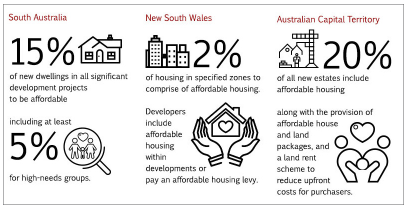Subscribe to keep up to date with the latest research, resources, news and events from The Deck.
You can also sign up to Q Shelter’s monthly newsletter, Home Matters.

MARCUS SPILLER, PH & MITRA ANDERSON-OLIVER SGS Economics & Planning Pty Ltd
Inclusionary Zoning (IZ) generally refers to statutory planning controls requiring development proponents to incorporate certain facilities or features on their site or pay a cash-in-lieu contribution for this obligation to be discharged off-site.
Traditionally, inclusionary provisions were applied to car parking requirements and open space contributions.
More recently, requirements to incorporate a certain proportion of affordable housing in a development project, or make a cash contribution for an equivalent quantum and standard of affordable housing to be provided elsewhere in the neighbourhood in question, have been contemplated and, in some cases, implemented, in Australian town planning practice.
This paper revisits the public policy merits of IZ. In doing so, a conservative perspective is taken on both the arguable scope of planning regulation and the appropriate application of economic principles in appraising net community benefit.
Even within this narrow frame, the paper finds that adoption of Ultimo-Pyrmont style IZ in Melbourne (and, indeed, elsewhere) has considerable prima facie merit. The substantive paper begins with the questions of what might be the readily defensible domain of planning regulation and whether the mandatory provision of affordable housing falls within this scope.
The discussion then turns to the standard economic tests of whether IZ is warranted in terms of allocative efficiency. However, before setting off on this discussion, some commentary on an additional economic perspective on IZ is warranted.
This relates to IZ as a legitimate exercise in value capture by government.